How to Make Meringue for the Airiest Desserts
Updated: Feb. 21, 2024
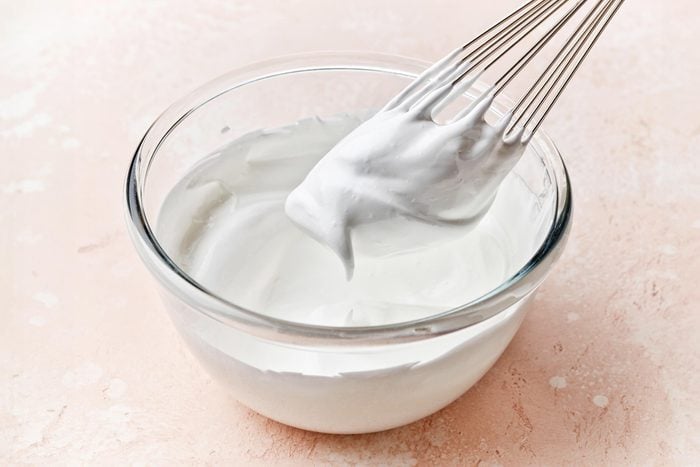
From topping mile-high pies to making delicate bite-sized cookies, meringue is incredibly versatile once you get the hang of making it. Here's how to get the texture exactly right.
Without meringue, we wouldn’t have lemon meringue pie, mousses would fall flat and shortcakes would turn out dense instead of pillowy.
You can enjoy the multi-purpose mixture as a dessert on its own, but it also makes delicate cookies with a chewy-meets-crunchy texture, serves as a base for shortcakes and provides a cloudlike topping on lemon pie and butterscotch pie.
Despite the three-ingredient dessert being so versatile, there are a few key tricks to keep in mind when whipping your own at home. Once you’ve accomplished the soft peaks vs. stiff peaks in the art of meringue, you’ll be on your way to creating pavlovas piled high with fresh fruit and baked Alaskas toasted to perfection.
On This Page
What is meringue?
Meringue is a whipped mixture of egg whites, cream of tartar and sugar. As the egg whites are whipped and air is incorporated, foam begins to form. Adding sugar and cream of tartar helps to stabilize this foam, giving meringue its signature fluffy texture.
Once a meringue is cooked, even for a short time, it becomes more stable. The whipping of the egg whites and the cooking period also helps to get rid of moisture, resulting in a chewy treat with a slightly crunchy exterior.
How do you use meringue?
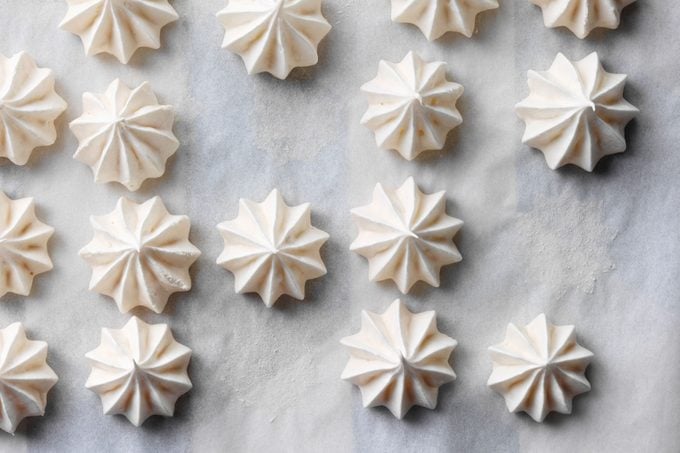
- Meringue pies: Meringue adds a delicious fluffy topping to pies, whether you’re adding it to citrus pies or topping a chocolate pie.
- Meringue cookies: Meringue can be piped with a piping bag or dropped by a spoon to make delicate little meringue cookies. Play with different colors, incorporate flavorings such as peppermint or add toppings like chocolate chips or sprinkles.
- Pavlova: Bake meringue in a circle to make regular-sized or mini pavlovas. These light and airy treats can then be dressed up with everything from fresh fruit and lemon curd to whipped cream and chocolate.
- Meringue frosting: Meringue frosting isn’t the same as a meringue topping for pies or the meringue used to make cookies and pavlovas. Meringue frosting is a cooked frosting made by simmering egg whites over a double boiler before whipping until stiff.
Ingredients for Meringue
- Egg whites: Whole eggs aren’t used to make meringue because the fat in egg yolks can prevent the mixture from whipping properly. It’s easier to separate eggs when they’re cold, but egg whites whip with better aeration at room temperature.
- Cream of tartar: Cream of tartar is acidic, and it works to add better stabilization to meringue. The acid can be substituted for lemon juice or vinegar.
- Sugar: Superfine sugar is best for meringue, as it aids in better absorption. If you don’t have superfine sugar, you can pulse granulated sugar in a food processor to make your own. If using regular granulated sugar, it’s important to mix it in gradually since it takes longer to incorporate smoothly.
How to Make Meringue
Ingredients
- 4 large egg whites, room temperature
- 1/4 teaspoon cream of tartar
- 1/2 cup sugar
Directions
Step 1: Beat the egg whites and cream of tartar
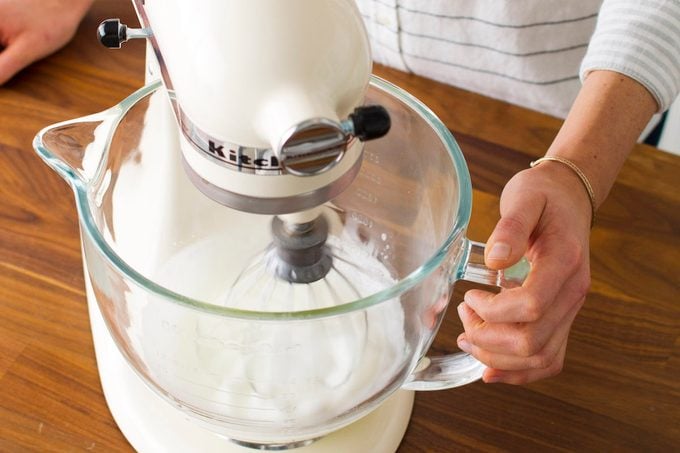
In a large mixing bowl, or the bowl of a stand mixer fitted with the whisk attachment, start to beat the egg whites and cream of tartar. Beat until soft peaks form.
Editor’s Tip: Be sure your equipment is cleaned and dried thoroughly. Any fat or food on the equipment will prevent the meringue from whipping properly.
Step 2: Slowly add the sugar
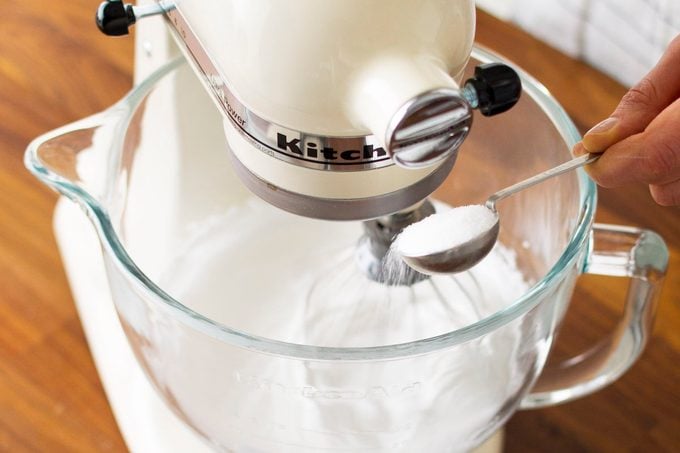
Gradually add the sugar into the egg whites while beating.
Step 3: Beat until stiff peaks form
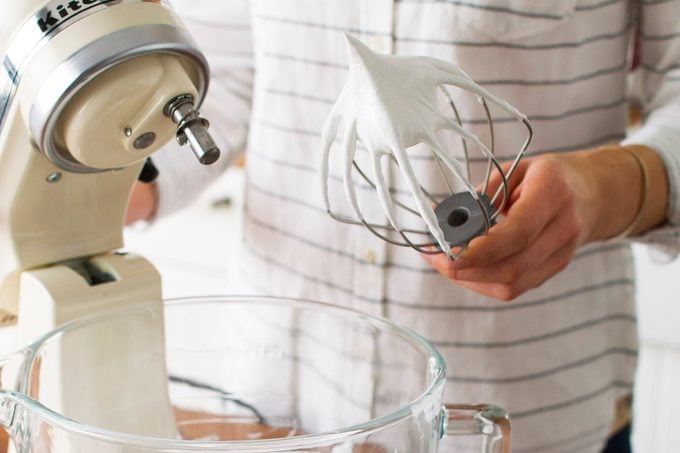
Continue to beat the egg whites until glossy, stiff peaks form.
Meringue Variations
- Peppermint meringue: The light, airy texture of meringue is a wonderful pairing for peppermint. Beat 1/2 teaspoon of pure peppermint extract into the stiff egg whites.
- Colored meringue: Add a few drops of your favorite color to the stiff egg whites mixture. This is a great way to make boldly colored meringue cookies for any holiday or occasion. You can also choose to paint the inside of a piping bag with food coloring before filling it with meringue for a swirled effect, like these holiday meringue cookies.
- Lemon meringue: For a light lemon flavor, fold lemon zest into the whipped meringue before baking.
- Meringue with mix-ins: Add finely chopped mix-ins such as walnuts, candied cherries or mini chocolate chips to your meringue cookies or mini pavlovas. Gently fold the additions into the meringue before baking.
- Dipped meringue: Once meringue cookies or pavlovas have been baked, dress them up even further. Melt chocolate and dip the bottoms into it.
How long does meringue last?
Freshly whipped meringue should only be out on the counter for 10 to 20 minutes before it will likely deflate. Use uncooked meringue as soon as possible. Baked meringue can be stored at room temperature in an airtight container for up to two weeks. Keep the stored meringue in a cool place away from direct sunlight to avoid any accumulation of moisture.
Can you make meringue ahead of time?
Meringue should be made as close to when you’re ready to use it as possible. That means whipping egg whites while your pie crust is baking in the oven so it’s ready for topping. You can whip egg whites and bake meringue cookies or a pavlova ahead of time. This will allow them to achieve the proper texture.
Can you freeze meringue?
Freshly whipped raw meringue shouldn’t be frozen, but you can certainly freeze baked meringue cookies or pavlovas. Store baked meringue in an airtight container in the freezer for up to two months. When it’s time to enjoy your treats, remove them from the container and let them defrost on a plate to avoid too much condensation building up while you wait.
Meringue Tips
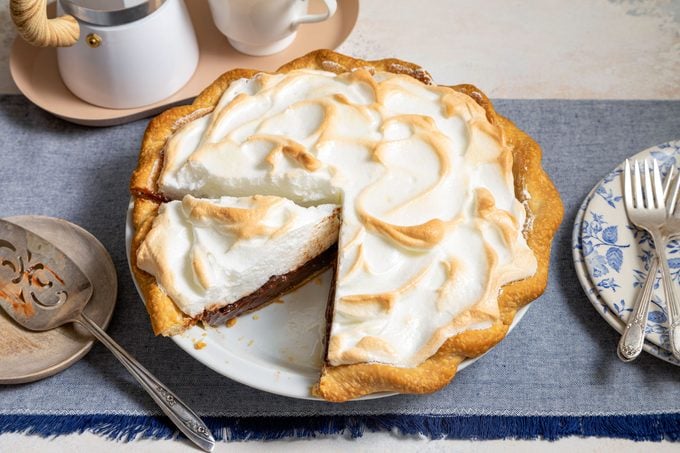
Can you make meringue without cream of tartar?
Cream of tartar is added to introduce acid, which helps with the stabilization of meringue. However, you can still achieve meringue without it—just expect that the final result won’t be quite as thick and fluffy. The sugar in the mixture will still help to stabilize the meringue and will stabilize even better if you choose to use superfine sugar.
Lemon juice or vinegar can also be swapped in for cream of tartar.
What is meringue powder?
Meringue powder is made up of dried, pasteurized egg whites, sugar and cornstarch. It can be used to stabilize royal icing for decorating cookies or whipped with water and sugar to form stiff meringue in place of liquid egg whites.
Why is my meringue runny?
When meringue is runny, it means the egg whites haven’t stabilized enough. This can happen if you haven’t whipped the egg whites long enough or if it sat out too long before baking. This can also happen if your egg whites weren’t quite up to room temperature before making the meringue.
Why does meringue weep?
Weeping, or the formation of moisture, occurs when meringue comes in contact with liquid. This can happen on top of meringue or in between pie filling and a meringue topping. To avoid weeping, be sure to spread the meringue over the entire pie, creating a seal to the edges. For best results, do this step while the filling is still hot.
